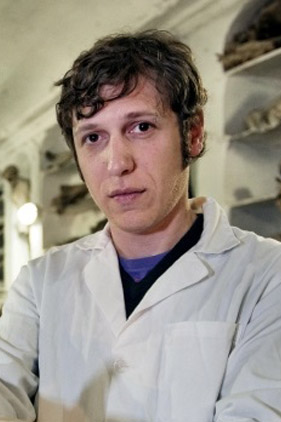July 2016, Year VIII, no. 7
Dario Piombino-Mascali
Smithsonian, eat your heart out!
“Human mummies are the focus of my research and I think that the stories these old bodies told me is reward enough for my efforts. Studying them is one way to shed light on what history has hidden from us.”
Telos: Paleoanthropologist. How did you become interested in what you call bodies that have tales to tell?
Dario Piombino-Mascali: At elementary school I learnt about the mummy of Blessed Eustochia, the saint from Messina who shortly afterwards was canonised by John Paul II in her hometown along the Straits. I asked my father if he’d take me to see her and remained unperturbed when I came face to face with her. That was the first time I came into contact with important remains that not only contain so much historical and biological data, but can also be studied and preserved for future generations. But my interest was well and truly sparked while studying at Pisa University. During my anthropology course, I discovered that I could become professionally involved with these artefacts, just like one can with archaeological artefacts or works of art. It immediately dawned on me that Sicilian mummies had never been examined and that they could become a unique research topic. In hindsight, I can say I was right. During the cursus honorum I was about to embark upon (graduate student, assistant, research doctorate, researcher and teacher) my focus was on human mummies, and I think that the stories these old bodies told me is reward enough for my efforts. But thinking back to the early days of this adventure of mine I would be amiss if I didn’t mention my mentor and maestro, the American pathologist Arthur Aufderheide, the father of the modern, scientific study of mummies who, when he was almost ninety, travelled around Sicily with me just to support me and launch the scientific project of which I am still director. Only his generosity and encouragement motivated me to go on rather than give up when I had to face the hostility of people who didn’t want to give young people opportunities, but instead did their best to monopolise this field of science. I know I owe him so much and, even now, I have very sad, but fond memories of him. In fact, I still have the tools he used to take on his scientific missions - sacred relics for scholars of mummies - and I’m thinking of donating them to a museum.
Would you share with us a few of the most interesting stories and secrets you’ve been told by your silent friends?
Actually there are so many, each with a different protagonist: the mummy of the Dutch peatlands, the mummies in a Lithuanian crypt or the famous mummies of Ferentillo, the internal organs of the Medici dynasty in Florence, and even an Egyptian mummy in the Vatican Museums. However, the mummies that made a lasting impression from a historical/medical point of view are, to start with, those in Salò, stone artefacts called petrifactions embalmed by Giovanni Battista Rini. When these petrifactions were studied they revealed the technique, based on the injection and immersion of preserving substances, used by this rather obscure doctor. Or the mummies of Savoca, aristocrats, churchmen and middle class citizens who led a comfortable life; we know this because their remains show they all had illnesses typical of longer life expectancy and a civilised lifestyle: gout and DISH.
Or the extremely interesting mummies of Piraino, priests who died in old age, one of which, suffering from multiple myeloma, had been treated with a medicinal plant that was not well-known in Europe. This plant was instead renowned in the East and even among American Indians. And how could I forget to mention the surprises we had while studying several Egyptian mummies? The first, housed in the Vatican Museums, was thought to be a female and instead it turned out to be unequivocally male. The same thing happened in Kaunas where the mummy was a low caste male rather than the unidentified singer of the god Amun, Shemait. Not to mention the two child mummies, one completely empty and the other with the hand of an adult. In short, the study of mummies is one way to shed light on what history has hidden from us.
Santa Lucia del Mela, an aristocratic small town in the province of Messina, hit the headlines when an extraordinary piece of news was published: it was to be the seat of the first school of studies of mummies in the world. Since you made it happen, can you tell us more?
Together with my American colleagues, we decided to organise a summer school for graduate students focusing on different research fields: forensic sciences, biology and archaeology. Not just the students at the University of Nebraska, the main project partner, but students from several overseas universities that had formed a consortium with it. Santa Lucia del Mela was not a random choice. It is a small town with noble origins and a huge historical and artistic heritage; a spectacular place you cannot but love. There is a small crypt under the Capuchin Church in Santa Lucia where dozens of mummies are buried; the crypt also contains the incorruptible body of the very important Blessed Antonio Franco, the Sicilian St. Francis who fought against usury in the early seventeenth century and whom I had the honour and privilege to preserve a few years ago.
The subjects we teach include paleopathology, anatomy, taphonomy, funerary archaeology, parasitology, palynology and the conservation and musealisation of mummies. It’s an opportunity to follow intensive, two-week courses on these theoretical disciplines and see the artefacts during visits to the most representative sites, such as Palermo and Piraino. A not-to-be-missed golden opportunity for our youngsters who have probably only see mummies in a museum. Amongst other things, the students will avoid extremely expensive travel costs thanks to a remarkable number of grants. A logic very different to the one in Italian universities.
Your words have drawn back the veil on the incredible heritage of mummies in Sicily, so much so that the island is a ‘must’ for any scholar. A tradition that sinks its roots in history. Can you tell us how it all started and then developed?
Actually its origins are lost in the mists of time, even if several studies have shown that we can associate mummification with ancient practices in the south where people considered death as a long, culturally sanctioned process. The soul had to reach the afterworld and was represented by the body, which instead had to be purified of its more turbid elements. In short, this prompted the construction of the colatoi (storage places where the fluids could drain away); these architectural structures were shaped like a seat or bed and used to facilitate the desiccation of the bodies. This practice continued until 1880 when it was prohibited by new hygiene and sanitary norms promulgated after the Unification of Italy. This interpretation appears to be corroborated by the numerous frescoes, paintings and even sculptures of the purged souls associated with these places of death. Nevertheless, chemicals were sill used at least until the 1930’s to produce several mummies: for example the bodies of little Rosalia Lombardo and the vice-consul of the United States, Giovanni Paterniti.
Editorial
If you think that mummies are a pastime for elderly enthusiasts and white haired lovers of Egypt, and a boring subject for members of the new digital generation or those of us who are slightly older, then get ready to think again. What’s more, be prepared to learn that mummies...talk. They give us detailed accounts of the lives of the men and women who have gone before us. Little stories in the Big story of the world. If mummies talk, then someone has to listen, understand and interpret what they say.
A paleoanthropologist, for example. The Sicilian Dario Piombino-Mascali, teacher and scholar of mummies, not yet forty, who takes us by the hand and leads us from Sicily to America - the homeland of Arthur Aufderheide, father of the modern science of mummies and his first mentor - and then back to the heart of Sicily. Along the journey we travel through Lithuania, Tuscany, Umbria and The Netherlands while he skilfully narrates the way his passion merges with the life of others. Noblemen, churchmen and craftsmen: mummies can reveal who they so jealously guard.
For instance, consumption of the limbs makes known the social status of an individual; likewise, certain senile diseases bear witness to a long, comfortable life. They are ‘bodies that have a story to tell’, an expression used by Piombino-Mascali to narrate his own story. Permeated by a rather extraordinary passion for paleoanthropology. One which prompted him to understand, study, research and travel far and wide. Until he returned home, enriched with a baggage of knowledge he made available to anyone who wished to listen. Home, we were saying. Yes, because Sicily - the place of another revelation! - is not just a land of almond trees and orange blossoms.
It is also a land of mummies. Piraino, Savoca, Palermo. Places that give living evidence to a technique - mummification - well known to ancient southern populations, bearers of a complex, fascinating culture of the dead. So what better place than this island, packed with history and culture, to open the first school of studies of mummies in the world? Santa Lucia del Mela, an aristocratic hamlet with a breathtaking view of the Aeolian Islands. The small town harbours an immense heritage for all paleoanthropologists, and it was here that Piombino-Mascali’s dream came true: to teach Italian and foreign students, enrolled in his school, about an incredibly fascinating mystery unknown to the masses. We’ve understood what he’s telling us: if we listen to mummies, they’ll tell us a story. And they’re more alive now than ever before.

Dario Piombino-Mascali is an anthropologist specialised in studies on mummies and paleopathology. He works with medieval and modern mummies, such as the Sicilian depositions and holy bodies. After finishing his classical studies at school, he studied at Pisa University where he graduated in 2002 with a thesis on the phylogenesis of hominids. While at university years, he was an Erasmus student in Leicester (England). Dario continued his studies and in 2007 obtained a research doctorate in Paleoanthropology and Pathocenosis. Immediately afterwards he started to work on mummies and in 2008 became a scientific advisor: he collaborated with several international television stations and newspapers including National Geographic, Fox, NatGeo, ZDF, Globo TV, Rai and Mediaset. He now teaches History of Medicine and Paleoanthropology at Messina University and is a visiting researcher at the University of Vilnius in Lithuania. He also collaborates with several research institutes on the scientific study of human remains in countries including the Vatican, Great Britain, Austria, Switzerland, Germany, Finland, Canada, Brazil, Korea, the Philippines and the United States.
He has founded and is currently the director of Mummy Studies in Sicily, a study project focusing on the mummies located in churches and crypts around the island. The Project performs historical and biomedical tests on the conservation of bodies. Since 2010 he is the scientific curator of the Capuchin Catacombs in Palermo. His mandate includes preserving the mummy of the little Rosalia Lombardo, nicknamed sleeping beauty for her carefully posed silhouette of a sleeping child. He has also performed comprehensive studies on the embalmer Alfredo Salafia and succeeded in discovering the chemical composition of the latter’s ‘secret formula’. Dario reviews the events that brought together Rosalia Lombardo and Professor Salafia in his book, Il Maestro del sonno eterno (The Maestro of Eternal Sleep), published in 2009. The list of his publications is endless, but some of the titles can be found here.
Born in Messina 39 years ago, he loves to travel, swim and jog. He enjoys reading history of art books and collects old photos of the Capuchin Catacombs in Palermo. But above all, he’s a great cook.







SocialTelos